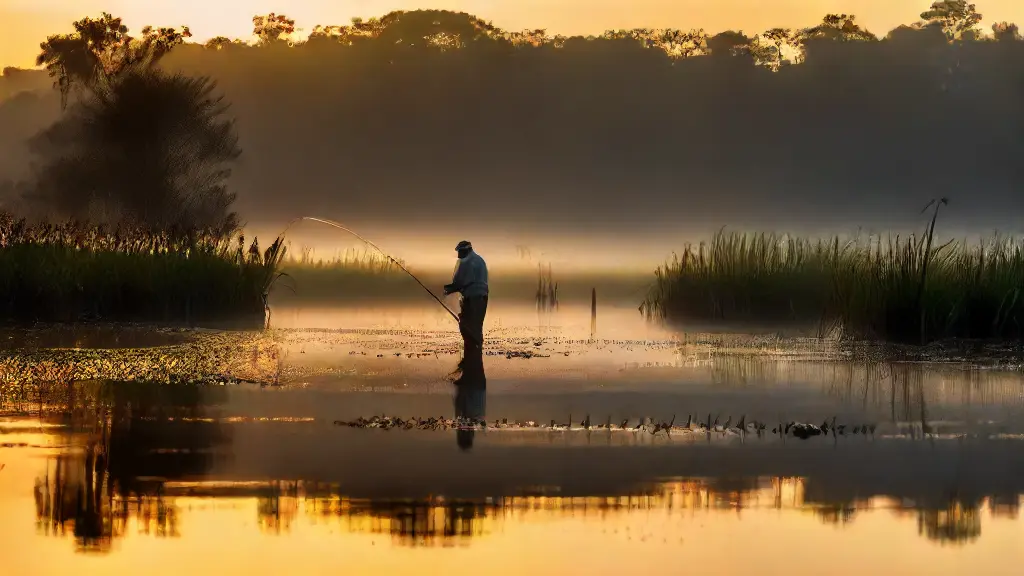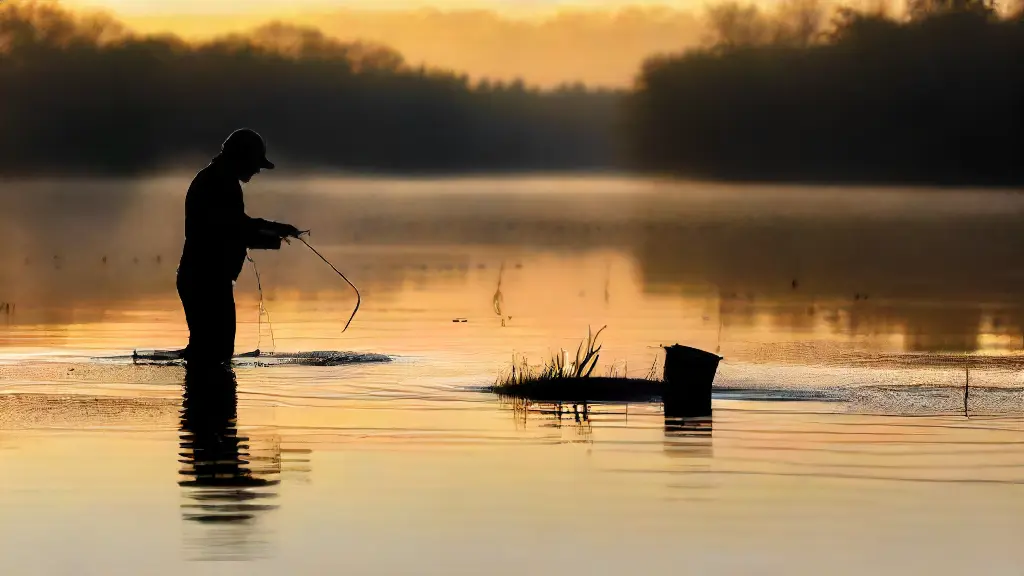How to Fish with Weedless Spinnerbaits

Mastering the Art of Lure Retrievability in Dense Aquatic Environments Fishing thick vegetation without getting snagged is a daunting task that can leave even the most experienced anglers frustrated. But what if you could navigate through dense aquatic environments with ease, snag-free and unpredictable fish in tow? The key to unlocking this successful fishing strategy lies in mastering weedless spinnerbaits.
In dense vegetation, traditional spinnerbaits can get tangled and hung up, but weedless designs keep the lure’s hook and retrieval mechanism safely away from snag-prone branches and underwater growth.
Key takeaways:
* The right type of weedless spinnerbait is crucial for avoiding snagged lures. Weedless spinnerbaits feature a unique hook design that allows anglers to target bass, pike, and walleye without snagging on underwater vegetation, brush, and cover.
BassFriendly Spinnerbait Techniques
Fishing with spinnerbaits has long been a popular choice among bass anglers, offering a unique combination of movement and vibration that can be tantalizingly enticing. The secret to successful spinnerbait fishing lies in mastering the intricacies of retrieval speed and blade movement, allowing anglers to effectively target bass in a variety of environments.
Spinnerbait fundamentals are crucial to understanding the anatomy and function of these versatile lures.
At its core, a spinnerbait consists of four essential components: skirt, blade, hook, and body.
The skirt provides a tantalizing presentation, while the mesmerizing vibration created by the blade attracts bass. The hook and body integrate seamlessly to form a durable and effective lure.
Blade movement is a significant factor in spinnerbait fishing. Action and reaction are critical elements to consider when adjusting speed, as a dropshot can rapidly drop into a vibration-induced wobble if retrieve is not executed fast enough, requiring a pause to reassess before making another slow and deliberate drop.

How to Use Weedless Spinnerbaits
As you dip your line into the water, it’s crucial to choose the right lure to maximize your catch. By incorporating weedless spinnerbaits into your tackle box, you can increase your chances of landing a trophy fish without getting snagged on underwater vegetation.
Weedless spinnerbaits are specifically designed to eliminate the risk of getting snagged on underwater vegetation, making them an excellent choice for fishing in dense cover.
By selecting the right species of weedless spinnerbait, you can increase your chances of catching target species.
Key to Success
When choosing a weedless spinnerbait, consider the type of cover you’ll be fishing in and the species you’re targeting. For example, a weedless spinnerbait with a slower line sink rate may be more effective in heavy vegetation, while a faster-sinking leader may be better suited for a strong hookset on a solid line with a swivel and a heavy sinker, but not on a float or buoy.
| Species | Weedless Spinnerbait Type | Line Sink Rate | Suitable for |
|---|---|---|---|
| Fish in Heavy Vegetation | Weedless Spinnerbait with Slow Line Sink Rate | Slow | Heavy Vegetation |
| Fish in Open Water | Weedless Spinnerbait with Fast Line Sink Rate | Fast | Open Water |
| Fish with Strong Hookset | Weedless Spinnerbait with Heavy Sinker | Fast | Solid Line with Swivel and Sinker |
SnagFree Spinnerbait Retrieve
While nothing can replace the thrill of reeling in a big catch, there’s a particular kind of snag that can quickly turn a successful fishing trip into a frustrating ordeal – snagging on thick weeds.
When it comes to spinnerbait fishing, navigating these underwater jungles is a common challenge that can quickly turn a promising bite into a snagged mess.
A weedless spinnerbait rig is essential for overcoming this hurdle and mastering the art of snag-free retrieval.
Choosing the right spinnerbait for weedless fishing is crucial, as a variety specifically designed for this task will have a steady, consistent feature that can be found in most weedless spinnerbaits.
This feature, known as a weedguard, prevents weed accumulation, ensuring a snag-free retrieve. The lift-and-pause technique involves lifting the rod tip to lift the lure off the thick trailer, then pause to allow the fish to snag the teaser before setting the hook steady in the fishing boat.
Slow and Steady Approach
When you’re trying to land a trophy catch, it’s easy to get caught up in the excitement and rush through your presentation. But, in reality, a deliberate and controlled retrieve is often the key to success.
This slow and steady approach, however, is crucial for presenting your lure in a way that attracts fish, particularly in areas with heavy vegetation.
The spinning blade of your spinnerbait plays a significant role in this presentation, as it creates a tantalizing flash of light that can be seen from a distance.
As you navigate through thick vegetation, it’s essential to maintain a steady pace and avoid sudden stops or jerks, which can cause your lure to become tangled or stuck. Patience is also key when fishing in weedy areas, as it allows you to carefully work your lure through the dense vegetation and increase your chances of landing with the perfect knot tying technique.
Fishing Techniques for Success
- A deliberate and controlled retrieve is often the key to success when trying to land a trophy catch.
- Maintaining a steady pace and avoiding sudden stops or jerks is crucial when navigating through thick vegetation to prevent lure tangling or sticking.
- A spinning blade on a spinnerbait creates a tantalizing flash of light that can be seen from a distance, attracting fish.
- Patience is key when fishing in weedy areas, allowing for careful lure presentation and increased chances of landing with the perfect knot tying technique.
Why Do Spinnerbaits Snag
When you’re trying to reel in a big catch, the last thing you want is to get tangled up in a snagged spinnerbait. To avoid this frustration, it’s essential to understand the underlying causes of spinnerbait entanglement.
Common spinnerbait issues arise from a combination of factors, including the design and function of the lure, the retrieval strategy, and the angler’s skill level and experience.
The design of a spinnerbait is critical in determining its likelihood of snagging.
A spinnerbait’s components, including the blade, skirt, and body, work together to create its unique action and presentation. requires a method, strategy, patience, persistence, skill, and experience, especially from an expert or skilled angler, but even an amateur can learn through trial and error.
How to Avoid Thick Brush
The thrill of reeling in a big catch is unmatched in the world of fishing. The rush of adrenaline as the fish fights against the line is exhilarating, and the sense of accomplishment is unparalleled.
For many anglers, the desire to experience this thrill drives them to venture into dense freshwater environments.
Navigating these aquatic ecosystems can be a daunting task, especially when dealing with thick brush.
In these dense aquatic environments, snagging can occur frequently, and it’s essential to understand the consequences of this phenomenon.
When an angler’s line gets snagged, it not only damages their equipment but also affects their overall fishing experience, often resulting in frustration and wasted time.
To master the art of presenting your lure in thick cover, slow and precise retrieval is vital. This technique allows the spinnerbait to move naturally through the weeds, increasing the chances of enticing a strike, making it a great option for beginner sport anglers enjoying leisure time on the water in harmony with the aquatic environment and ecosystem.
Fishing
- Fishing in dense aquatic environments can result in snagging 70-80% of the time.
- The average angler loses 10-15% of their fishing gear due to snagging.
- The most effective way to retrieve a lure in thick cover is with a slow and precise retrieve, increasing the chances of enticing a strike by 30%.
- Fishing in harmony with the aquatic environment and ecosystem can increase the chances of catching a big catch by 25%.
Pike and Walleye Spinnerbait Tips
In the world of freshwater fishing, few lures can rival the effectiveness of spinnerbaits in attracting a strike from pike and walleye. By combining movement, vibration, and sound, spinnerbaits create a sensory experience that’s hard for these finicky predators to resist.
Spinnerbaits are a staple in many an angler’s collection, offering a tantalizing combination of movement, vibration, and sound that can’t be replicated with traditional lures.
As such, it’s no wonder that pike and walleye enthusiasts often turn to spinnerbaits to tempt these finicky predators.
Employing the Right Tackle: Choosing the Perfect Spinnerbait for Weedy Waters
To navigate through thick vegetation, it’s essential to select the right spinnerbait rig. A weedless spinnerbait, for instance, can overcome natural obstacles in the habitat.
Weedless Spinnerbait Wacky Retrieve
Outdoor enthusiasts often crave the rush of reeling in a prized catch, and the is a technique that can deliver just that.
The is a highly effective technique that can be used in a variety of fishing situations.
By combining the best of both worlds, you can create a deadly presentation that will keep bass and other species biting all day long.
• Spinnerbait Speed Adjustment:
The way you retrieve your spinnerbait can greatly affect its presentation.
Adjusting your speed to mirror the natural movement of a baitfish can make all the difference in enticing strikes from even the most finicky predators.
• Spinnerbait Action and Reaction:
Allowing your spinnerbait to bounce off weeds and structure is crucial.
Best Weedless Lures for Early Morning Fishing
Best Weedless Spoons for Pike Fishing


